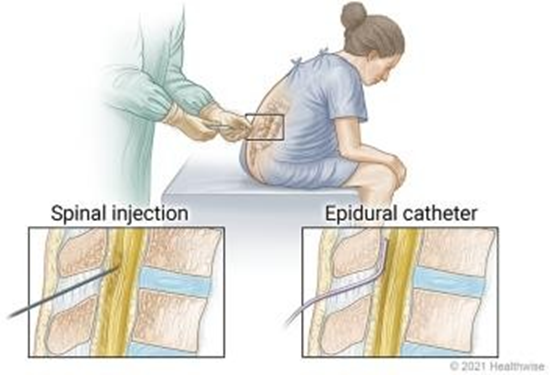A nurse is assessing a client who is in labor and is receiving epidural anesthesia. Which of the following findings should the nurse identify as the priority?
Urinary retention
Leg weakness
Hypotension
Temperature 39°C (102.2°F)
The Correct Answer is C
A. Urinary retention: While urinary retention can be a complication of epidural anesthesia, it is not the priority finding in this scenario. The priority is to address potential complications that can lead to maternal or fetal compromise.
B. Leg weakness: Leg weakness can occur as a side effect of epidural anesthesia but is not the priority finding in this scenario unless it is severe and compromises the client's ability to
mobilize or push during labor.
C. Hypotension: Hypotension is a common complication of epidural anesthesia due to sympathetic blockade, which can lead to decreased venous return and subsequent maternal
hypotension. Maternal hypotension can compromise uteroplacental perfusion, leading to fetal distress. Therefore, addressing hypotension promptly is the priority to prevent adverse maternal and fetal outcomes.
D. Temperature 39°C (102.2°F): While fever should be monitored and addressed, it is not the priority finding in this scenario unless it indicates an infection, which would require further assessment and intervention. However, maternal hypotension poses a more immediate risk to both the mother and the fetus during labor.

Nursing Test Bank
Naxlex Comprehensive Predictor Exams
Related Questions
Correct Answer is ["7.5"]
Explanation
Convert the client's weight from pounds to kilograms. We can use the formula 1 kg = 2.2 lb. So, 132 lb / 2.2 = 60 kg.
Calculate the total daily dose of chloramphenicol for the client. We can use the formula Dose (mg) = Weight (kg) x Dosage (mg/kg). So, 60 kg x 50 mg/kg = 3000 mg.
Divide the total daily dose by 4 to get the dose for each administration. So, 3000 mg / 4 = 750 mg.
Calculate the volume of chloramphenicol solution needed for each dose. We can use the formula Volume (mL) = Dose (mg) / Concentration (mg/mL). So, 750 mg / 100 mg/mL =
7.5 mL.
Round the answer to the nearest tenth. So, the nurse should give 7.5 mL of chloramphenicol solution with each dose.
Correct Answer is A
Explanation
A. Oxycodone, like other opioid medications, can cause constipation, so advising the client to take a stool softener can help prevent or alleviate this common side effect.
B. Urinary frequency is not a common side effect of oxycodone.
C. There is no known association between oxycodone and sunlight exposure, so advising the client to minimize sunlight exposure is unnecessary.
D. Oxycodone can be taken with or without food, so there is no requirement to take it on an empty stomach.
Whether you are a student looking to ace your exams or a practicing nurse seeking to enhance your expertise , our nursing education contents will empower you with the confidence and competence to make a difference in the lives of patients and become a respected leader in the healthcare field.
Visit Naxlex, invest in your future and unlock endless possibilities with our unparalleled nursing education contents today
Report Wrong Answer on the Current Question
Do you disagree with the answer? If yes, what is your expected answer? Explain.
Kindly be descriptive with the issue you are facing.
